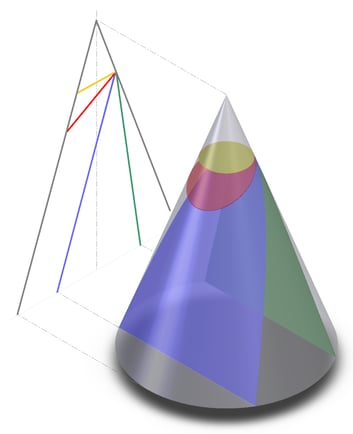
You will usually see one conic section question (though no more than one) on any given ACT, but just what is a conic section and how do you solve it? Luckily for us, though conic section questions are rare, they are generally straightforward and can get you an easy point if you take a few minutes to study them.
This will be your complete guide to conic sections—what they are, how you'll see them on the test, and the best way to approach these types of ACT math questions.
What Are Conic Sections?
A conic section is any intersection of a cone (a three dimensional figure) and a plane (a flat, infinite surface). Depending on how the plane slices the cone, the intersection will create:
- A circle
- A parabola
- An ellipse
- A hyperbola
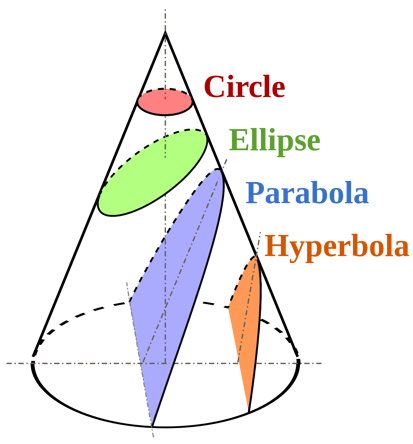
Picture: Magister Mathematicae/Wikimedia
For the ACT, you will only need to know about circles and parabolas. And the only parabola knowledge you'll need are covered by your quadratic functions.
The ACT will never test you on ellipses or hyperbolas.
What You'll Need to Know About Conic Sections
The only piece of information you really need to understand to master conic sections on the ACT is the equation of a circle. Every ACT conic section question will ask you information about this equation and you must either find the proper equation from given information or identify the individual pieces that make up this equation.
Equation of a Circle
$$(x - h)^2 + (y - k)^2 = r^2$$
This is the equation of a circle.
$h$ and $k$ are the coordinates for the center of the circle. $h$ stands in place of the $x$-coordinate and $k$stands in place of the $y$-coordinate. The center will, therefore, be at $(h, k)$.
$r$ is the radius of the circle.

♪ Love (and the equation of a circle) is all you need. ♪
Picture: byronv2/Flickr
Typical ACT Conic Section Questions
Though you will only have to know the equation of a circle to solve your conic section questions, you may see conic section questions in a few different ways—as a word problem, as a diagram problem, and/or as a scenario problem. But no matter their form, it should be pretty straightforward to solve the problem if you remember your formula.
Let's look at a typical ACT conic section problem.
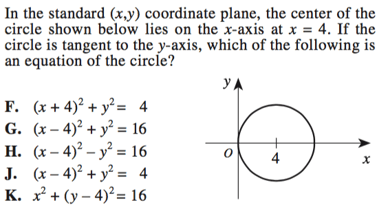
We can see, based on the graph, that our center coordinates for our circle are $(4, 0)$. This means that we can count from the circumference to the center to find that our radius is also 4. So if we replace these values with our $(h, k)$ and our $r$ in the equation for a circle, we would get:
$(x - h)^2 + (y - k)^2 = r^2$
$(x - 4)^2 + (y - 0)^2 = 4^2$
$(x - 4)^2 + y^2 = 16$
This means that our final answer is G.
ACT Math Strategies for Conic Section Questions
Though conic sections are generally fairly simple, you will be able to solve them more easily if you use strategy (especially if you forget your key information on test day).
#1: Prioritize Your Time and Energy
Conic sections are one of the least common ACT math topics. This type of question may or may not show up on your ACT, and even if it does, there will only be one question on circle equations per test. Though it is not a guarantee that you will see it, it is a useful formula for you to know if you're trying for every last math point.
#2: Memorize the Circle Formula
If you're going for every last point, then be sure to memorize your circle formula. On every ACT conic section question, you will be given a string of answer choices that all look incredibly similar. This is to muddy the waters for anyone who only has a passing recollection (or no recollection) of the formula.
Your best bet for a near guaranteed point on all conic section questions is to simply memorize the formula and quiz yourself on it before test day to make sure you have it down.
#3: Alternatively, Remember Just a Piece of the Formula and Guess Strategically
If you're worried for any reason that you'll forget your formula or if you would just rather spend your time memorizing more common ACT math formulas like slopes and angles, then even remembering a piece of the circle formula is better than not memorizing any part of it at all.
For instance, if you don't remember the $(x - h)^2 + (y - k)^2$ side of the formula, but you do remember that the other side is the radius squared (and not just the radius), you will often be able to eliminate two or three answer choices. Now you have between a 33% and a 50% of guessing the right answer, which is certainly better than a 20% blind guess.
So pick just a piece of the circle formula and commit it to heart, even if you can't or won't for any reason memorize the whole thing.
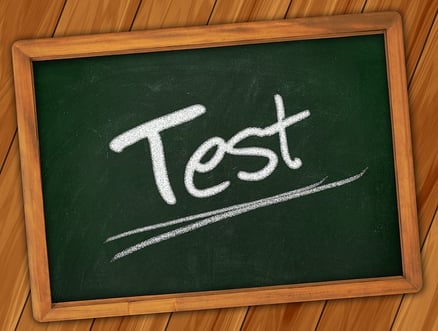 Ready to show 'em what you got?
Ready to show 'em what you got?
Test Your Knowledge
So let's put your knowledge to the test on real ACT math problems about conic sections.
1.
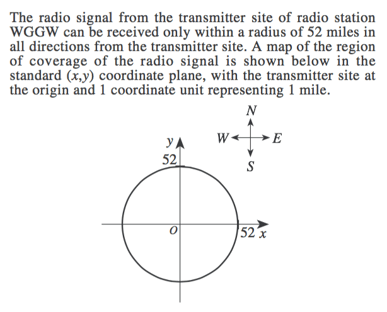
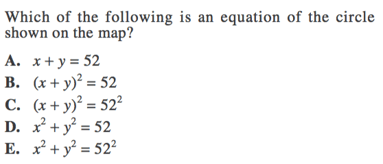
2.
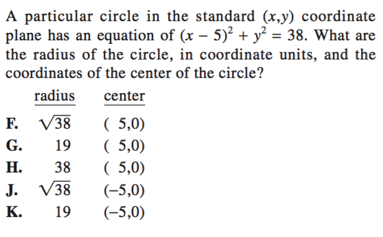
3. If a circle has a circumference that is tangent to the origin and a midpoint at $(0, -7)$, which of the following is the equation of that circle?
A. $x^2 + (y - 7)^2 = 49$
B. $x ^2 + (y + 7)^2 = 49$
C. $(x - 7)^2 - y^2 = 49$
D. $(x - 7)^2 + y^2 = 7$
E. $x^2 - y^2 = 7$
Answers: E, F, B
Answer Explanations:
1. For this problem, we know that our circle's midpoint is at the origin, which gives it the coordinates $(0,0)$. We can also see that the radius of the circle is 52. That means that our circle formula will be:
$(x - h)^2 + (y - k)^2 = r^2$
$(x - 0)^2 + (y - 0)^2 = 52^2$
$x^2 + y^2 = 52^2$
Our final answer is E, $x^2 + y^2 = 52^2$
2. For this question, we are actually working backwards, but the principle of the circle formula hold true. We must simply use the values we are given and reverse engineer them to find what we need.
We know that our circle formula is:
$(x - h)^2 + (y - k)^2 = r^2$
If our equation is then:
$(x - 5)^2 + y ^2 = 38$, then we know that the radius must be the square root of 38 and the midpoint must be $(5, 0)$.
Our final answer is F.
3. As usual when working without a diagram, let's draw a quick sketch of the scene. We know that the midpoint is at $(0, -7)$ and the circle is tangent to the origin, so this is the circle we're dealing with.
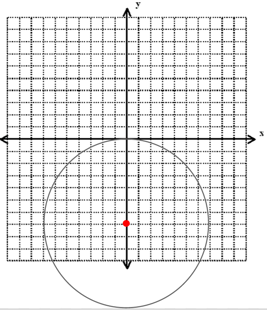
We know that the radius is, therefore, 7 and we can plug the midpoint values into our equation.
$(x - h)^2 + (y - k)^2 = r^2$
$(x - 0)^2 + (y - -7)^2 = 7^2$
$x^2 + (y + 7)^2 = 49$
Our final answer is B, $x^2 + (y + 7)^2 = 49$
The Take-Aways
Though conic section questions are relatively rare, if you're going for every last point, it's a good idea to memorize your circle formula (or even just a piece of it) for a quick point. You will never be asked to do more than identify it when you see it or to identify its pieces, so go ahead and grab it if you can.
What's Next?
Want to brush up on any of your other math topics? Check out our individual math guides to get the walk-through on each and every topic on the ACT math test. You should also be sure to take a look at our articles on how to complete the square and the four different graph quadrants.
Worried what the Ivy Leagues think of the ACT? Learn how some of the top schools in the United States feel about the ACT vs. the SAT.
Running out of time on the ACT math section? We'll teach you how to beat the clock and maximize your ACT math score.
Trying to get a perfect score? Check out our guide to getting a perfect 36 on ACT math, written by a perfect-scorer.
Want to improve your ACT score by 4 points?
Check out our best-in-class online ACT prep program. We guarantee your money back if you don't improve your ACT score by 4 points or more.
Our program is entirely online, and it customizes what you study to your strengths and weaknesses. If you liked this Math lesson, you'll love our program. Along with more detailed lessons, you'll get thousands of practice problems organized by individual skills so you learn most effectively. We'll also give you a step-by-step program to follow so you'll never be confused about what to study next.
Check out our 5-day free trial:
Have friends who also need help with test prep? Share this article!

Courtney scored in the 99th percentile on the SAT in high school and went on to graduate from Stanford University with a degree in Cultural and Social Anthropology. She is passionate about bringing education and the tools to succeed to students from all backgrounds and walks of life, as she believes open education is one of the great societal equalizers. She has years of tutoring experience and writes creative works in her free time.


































 Holly R.
Holly R.